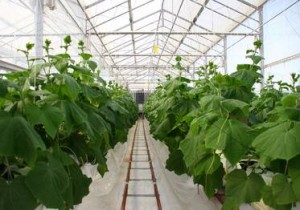November 19, 2013 – Conceived to turn the desert sands of the Sahara into productive agricultural land, the Sahara Forest Project, a Norwegian-based initiative, has recently completed a two-and-a-half year pilot project in Qatar to test the feasibility of the technology needed for the task.
The Sahara is the largest continuous desert in the world covering an area over 9.4 million square kilometers (3.6 million square miles). That makes it as big as the United States. It occupies much of the northern part of Africa stretching from the Atlantic in the west to the Horn of Africa in the east. But the Sahara over the last 12,000 years has not always been the barren, dry place it is today. Just 10,500 years ago the climate was far wetter with much of the desert receiving adequate rain to support a rich savannah of grasslands intermixed with small forested areas. The now desert landscape was spotted with lakes and human settlements. But the land reverted to desert when the seasonal rains petered out between 7,300 and 5,500 years ago. Today the Sahara is one of the driest places on the planet and it is extending further south into areas with large human populations creating conditions that will spawn climate refugees, not just humans but animals and plants as well.
The Sahara Forest Project hopes to reverse the desertification and restore the region to an agricultural Eden. To succeed the Project has brought together a partnership of companies and governments with particular expertise and Qatar has become their test bed for working out the kinks.
In 2011 the Qatar site got underway with the building of a greenhouse along with a solar power facility and the laying of a pipeline to bring in saltwater. The first year results saw the successful re-vegetation of a small area of the desert with the saltwater-cooled greenhouses growing three cycles of vegetable crops under glass. The saltwater-based cooling system provided enough moisture in the air to cause condensation creating freshwater for drip irrigation. Salt precipitated out from the seawater could be harvested as well. And salt-loving fodder crops were also introduced for animal feed and for bioenergy feedstock production, particularly marine algae.
This first year has proven the concept brilliantly. Here are some of the results:
- Crop yields have been equal to the best commercial greenhouse operations in Europe producing three full harvests in the first year.
- Freshwater irrigation usage has been half of what it is used in comparable greenhouse operations elsewhere in Qatar.
- Solar desalinization technologies have worked effectively without corrosion in any of the system’s pipes proving that it is viable and can be rolled out to larger project sites.
- Growth of vegetation on the perimeter of the operations has created collateral benefits providing additional cooling and shad and the re-vegetation of a much larger area making it possible to plant additional food crops without requiring any significant additional irrigation.
- Additional commercial output from the project beyond produce has included salt and algae-derived biofuels for resale.
Who are the organizations and companies involved? They are:
Exploration Architecture – a London, UK firm noted for expertise in bio-mimicry in its architectural design solutions.
The Bellona Foundation – an Oslo, Norway environmental specialist working on renewable energy projects and focused on solutions to climate change.
CIRiS – the Centre for Interdisciplinary Research in Space, located in Norway and focused on applied agricultural research in controlled environments.
DOE – the United States Department of Energy Research, providing expertise on marine algae production for the commercial development of biofuels and feeds.
Sundrop Farms – a company based in the United Kingdom on the Isle of Man and a leader in sustainable agriculture in arid conditions with additional sites in Australia.
No mention of where and when the first Saharan location will get started but the implication of the greening of even a portion of the Sahara for world food production is enormous. And when you consider that human population is expected to reach in excess of 9 billion by mid-century, every hectare of cultivated land will be extremely important.














I love your posts. Eclectic. Informative. Wonder inducing.
[…] Conceived to turn the desert sands of the Sahara into productive agricultural land, the Sahara Forest Project, a Norwegian-based initiative, has recently completed a two-and-a-half year pilot project in Qatar to test the feasibility of the technology needed for the task. […]
[…] Sahara Forest Project is a multi-company, multi-government venture focused on creating technology for growing crops in the world's deserts. […]
I love this project. What are the stats on condensation. I believe the night sky can condense evaporated water from salt water during the day and precipitate it down the walls of a properly designed greenhouse tunnel. A long expired patent of mine proposed such a structure for the Nevada desert.